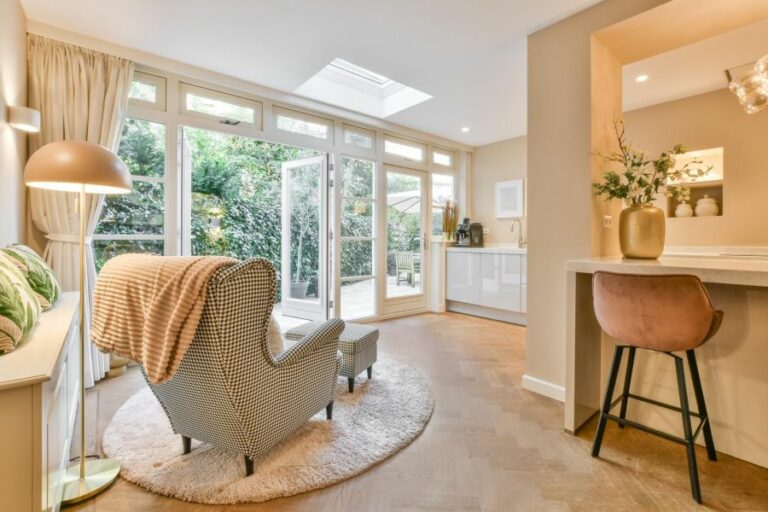Cozy Indoor Paint Color Choices, 25 Things You Should Know
Choosing the perfect paint color for your home can be both exciting and overwhelming, but fear not; I am here to guide you through it. As an expert in cozy indoor paint colors, we can help you transform your space into a warm and welcoming haven.
Cozy indoor paint color choices:
Cozy indoor paint color choices include warm neutrals like soft beige and warm gray, earth tones such as sage green and terracotta, and pastel hues like soft blue and blush pink. These colors create a comfortable and inviting atmosphere in living spaces, contributing to well-being and mental health.

Ready to transform your home into a cozy sanctuary? Discover the perfect paint colors that can help you create a warm, inviting atmosphere. From calming neutrals to sophisticated hues, I’ve got you covered. So, grab your paintbrush, and let’s get inspired together!
Contents
- 1 Comfortable Interior Paint Color Options
- 2 Paint Colors That Create a Homey Atmosphere
- 3 Top Colors for a Warm and Inviting Room
- 4 Most Relaxing and Calming Paint Color
- 5 Warm and Vibrant Paint Color Selections
Comfortable Interior Paint Color Options
Everyone wants to create a comfortable and inviting atmosphere in their home. Choosing the right paint colors plays a significant role in setting the mood and the overall vibe of your living spaces.
Selecting cozy indoor paint colors not only enhances the ambiance of your home but also contributes to your well-being and mental health.
• Warm Neutrals: Evoke Comfort and Calm
Warm neutrals are an excellent choice for creating cozy living spaces. Colors like soft beige, creamy whites, and warm grays evoke tranquility and comfort, making them perfect for bedrooms, living rooms, and family areas.
– Soft Beige: A Versatile and Timeless Choice
Soft beige is a classic neutral color that complements most interior styles. Whether you have a traditional or contemporary design, this color adds warmth while keeping the space looking clean and relaxed. One popular soft beige paint color is Sherwin-Williams Accessible Beige.
– Warm Gray: Subtle, Soothing, and Modern
Warm gray is an excellent alternative to beige and works perfectly for a modern or transitional design scheme. It offers a subtle hint of color while still creating a cozy and soothing atmosphere. A popular warm gray paint color choice is Benjamin Moore Revere Pewter.
• Earth Tones: Tapping into Nature’s Palette
Earth tones are a fantastic option for homeowners who want to create a cozy space that reflects the natural world. Rich and grounded, these colors can make any room feel inviting and warm.
– Sage Green: Peaceful and Harmonious
Sage green is a muted and calming color that complements various design styles, from traditional to rustic. This gentle hue can create a sense of harmony and balance in your indoor spaces. A popular sage green paint choice is Farrow and Ball’s Overtly Olive.
– Terracotta: Rich and Earthy
Terracotta is a warm and earthy color that adds depth and richness to any room. It works exceptionally well in Southwestern and Mediterranean-style homes. A popular terracotta paint choice is Dunn-Edwards’ Warm Butterscotch.
• Pastel Hues: Soft and Serene Ambiance
Pastel colors offer soft and delicate hues that can create a serene and peaceful atmosphere in any room. They are perfect for homeowners who want a more subtle and soothing color palette that still feels cozy.
– Soft Blue: Fresh and Serene
Soft blue creates a fresh and serene atmosphere, making it the ideal choice for bedrooms, bathrooms, or any relaxation area. A popular soft blue paint is Behr’s Watery.
– Blush Pink: Warm and Delicate
Blush pink is a warm and subtle color that evokes feelings of comfort and romance. It can be used in various settings, from bedrooms to living rooms, to create a cozy and inviting atmosphere. One popular blush pink paint choice is Valspar’s Pale Pastel Pink.
• Tips for Choosing the Right Cozy Indoor Paint Color
While choosing the right color is essential, it’s also crucial to consider how that color will interact with your furnishings, lighting, and room size. Here are a few tips to help you make the best decisions:
- Observe how the color looks in different lighting conditions: Test your chosen paint color in the room during different times of the day to see how the lighting affects the hue.
- Use visual tools to preview your paint choices: Online visualization tools like Behr’s ColorSmart or Sherwin-Williams’ ColorSnap Visualizer can help you see how your desired colors will look in your space.
- Consider the room size: Light colors generally make a room feel more spacious, while dark colors make the room feel smaller and cozier. Choose your paint colors accordingly to enhance the size and shape of the room.
In conclusion, selecting cozy indoor paint colors is an essential step in creating an inviting and comfortable atmosphere in your home. By exploring warm neutrals, earth tones, and pastel hues, you can transform your living spaces into serene havens for relaxation and rejuvenation.
Remember to consider your personal taste, design style, and the room’s size and lighting when making your final decisions. With the right color choices, your home will radiate warmth and coziness for years to come.
Paint Colors That Create a Homey Atmosphere
A cozy atmosphere in a home is something many people desire. Different elements contribute to achieving this feeling, and one of the most important factors is the choice of paint color.
• Warm Tones for a Cozy Ambience
Warm colors such as reds, oranges, and yellows can create a cozy and inviting atmosphere in a home. These colors are reminiscent of a warm fire or the glow of the sun, which can evoke feelings of warmth and comfort.
– Earthy Browns and Reds
Earthy browns and reds, such as terracotta, burnt sienna, and deep ochre, can create a sense of warmth and comfort in a room. These colors are reminiscent of natural materials like clay and wood, which can create a welcoming and grounded atmosphere.
Incorporate these colors into your home by painting an accent wall, choosing complementary furniture, or adding decorative elements with similar tones.
– Sunny Yellows and Oranges
Yellows and oranges, particularly those with warmer undertones, can inject energy and warmth into a space. Colors like mustard, marigold, or apricot can brighten up a room while still maintaining a cozy atmosphere.
Be cautious, though, as using too much of these vibrant colors can become overwhelming. Instead, opt for a single accent wall or incorporate these colors through textiles and decor pieces.
– Soft Gold and Bronze
Soft gold and bronze tones can bring warmth and elegance to a space. These colors can work well in living rooms or bedrooms, creating a luxurious and comforting ambiance. To achieve this look, consider choosing a subtle metallic or shimmer finish for your paint to add depth and interest.
• Cool Tones for a Soothing Sanctuary
Although warm tones are often associated with coziness, cool colors can also make a home feel cozy by creating a calming and serene atmosphere. Blues, greens, and grays with warmer undertones can evoke a sense of comfort and relaxation in a room.
– Muted Greens
Muted greens, like sage and olive, can create a calming atmosphere in a home – reminiscent of nature and the outdoors. These colors can work well in bedrooms, living rooms, or even bathrooms, providing a soothing and peaceful environment.
Pair muted greens with natural materials like wood or rattan for a harmonious and earthy vibe.
– Soft Blues
Soft blues, such as sky blue or dusty blue, can create a serene and tranquil atmosphere in a room. These colors can make a space feel soothing and relaxing, perfect for creating a cozy bedroom or living area.
Consider pairing soft blues with warm neutral tones, such as creams or beiges, for a balanced and calming color scheme.
– Cozy Grays
Grays with warm undertones, like greige or taupe, can create a cozy yet sophisticated atmosphere in a room. These colors are versatile and can easily complement a variety of decor styles and color schemes.
Incorporate cozy grays through wall paint, furniture, or textiles to create a warm and inviting home environment.
• Choosing the Perfect Cozy Color for Each Room
When selecting paint colors for your home, consider the function of each room and the atmosphere you want to create. Here are some tips on choosing cozy colors for various rooms:
– Living Room
In a living room, where family and friends gather, choose a warm and inviting color that encourages conversation and relaxation. Warm neutrals, earthy reds, or soft blues can all work well in this space.
– Bedroom
For a bedroom, aim for a soothing and calming color scheme that promotes rest and relaxation. Soft blues, muted greens, and cozy grays are perfect choices for creating a peaceful sanctuary.
– Kitchen
In a kitchen, consider a color that invokes warmth and energy, such as a sunny yellow or a warm orange. Alternatively, a cozy gray can work well for a more modern and sophisticated kitchen design.
– Bathroom
In the bathroom, opt for soothing and calming colors like soft blues or muted greens, which can create a tranquil and spa-like atmosphere.
In conclusion, the choice of paint color plays a vital role in creating a cozy and welcoming home. By considering the function of each room and selecting colors that promote warmth, comfort, and relaxation, you can transform your house into a cozy sanctuary.
Experiment with different shades and finishes to find the perfect cozy color scheme for your home.
Top Colors for a Warm and Inviting Room
One of the key aspects that contribute to the overall atmosphere and ambiance of a room is its color. The choice of color can evoke emotions, set the mood, and even influence one’s well-being.
In order to create a cozy and inviting space, it is essential to select a color that promotes warmth and tranquility.
• The Impact of Warm and Cool Colors
Colors are generally classified into two categories: warm and cool. Warm colors, such as reds, oranges, and yellows, are often associated with excitement, energy, and happiness, while cool colors – blues, greens, and purples – are linked to calmness, relaxation, and creativity.
To create the desired atmosphere of a cozy room, it is crucial to take these color characteristics into consideration.
– Embracing the Warmth of Earthy Tones
Earthy tones are a popular choice for cozy interiors, as they exude warmth, comfort, and a sense of belonging. These hues, often derived from natural elements, connect us to the outdoors and bring a sense of tranquility and balance to our indoor spaces.
Terracotta: A Warm, Rustic Hue
Terracotta, a warm orange-brown color, is reminiscent of the sun-kissed landscape of the Mediterranean. This hue creates an inviting and comfortable environment when incorporated into a room. As a bonus, terracotta is a versatile shade that can be easily complemented by a range of other colors.
Pair terracotta walls with neutral furnishings, or add splashes of blues and greens for a more dynamic and modern look.
Muted Greens: A Soothing Connection to Nature
Bringing the outdoors in has always been a key element in creating a serene and warm atmosphere. Muted shades of green, such as sage, olive, or moss, help to achieve this effect while maintaining a sense of calm and balance.
These hues work exceptionally well in combination with natural materials, such as wood or stone, to create a harmonious and soothing environment.
– The Power of Neutrals: Comfort in Simplicity
Neutral colors, such as whites, beiges, and grays, have long been the go-to choice for creating cozy spaces. These versatile hues provide a clean, understated backdrop that allows other elements in the room, such as furniture, textiles, and lighting, to take center stage.
The Elegance of Gray
Gray is a timeless and sophisticated color that can add depth and warmth to any room. This versatile shade comes in various undertones, from warm, greige tones to cool, blue-tinged hues. When choosing a gray color for your room, consider the undertone that best complements your desired atmosphere.
A warm gray, for instance, can create a calming and cozy environment, while a cooler gray can provide a more elegant and understated feel.
– Incorporating Color Accents
While a cohesive color palette is essential in creating a warm atmosphere, incorporating accents and pops of color can add depth and visual interest, contributing to a sense of comfort and charm.
Consider incorporating accent colors through textiles, such as pillows, blankets, and curtains, or introduce colorful artwork or decorative accessories to enliven the space.
• The Importance of Lighting and Textures
When aiming for a cozy environment, the interplay of color, lighting, and texture is essential. Warm and soft lighting enhances the overall atmosphere, transforming even the simplest color palette into a soothing and inviting space.
In addition, incorporating a variety of textures and materials, such as natural fibers and warm, soft textiles, can further contribute to the cozy ambiance.
• Conclusion
In conclusion, the best color for a cozy room depends on the atmosphere one wishes to create. Earthy tones such as terracotta and muted greens elicit warmth and connection to nature, while neutral colors, especially grays with warm undertones, add elegance and sophistication.
Textural elements and warm lighting play a key role in enhancing the overall coziness of a space. For more information on color psychology and its impact on interior design, visit The American Psychological Association for further insights.
Color | Description |
|---|---|
Warm Tones | Colors like reds, oranges, and yellows create a cozy and welcoming atmosphere. |
Earth Tones | Browns, greens, and beige can also help create a warm and comfortable space. |
Soft Blues and Greens | These colors can create a calming and serene environment, fostering relaxation. |
Neutral Grays | Grays can be paired with other warm or cool colors to create a cozy environment. |
Most Relaxing and Calming Paint Color
• Introduction to Soothing Colors
Colors can have a profound impact on our emotions and psychological state. Certain colors have the ability to evoke a sense of calm and relaxation, while others can be stimulating or even agitating.
• The Impact of Colors on Our State of Mind
Research has shown that color can significantly alter an individual’s mood, perception, and overall well-being.
According to a study from the National Center for Biotechnology Information, colors can evoke both physiological and psychological responses that can either help to improve or worsen one’s mental state.
With this understanding, it is essential to recognize the immense power that colors hold in evoking feelings of calm and relaxation.
• Discovering the Most Soothing Color: Blue
Blue, particularly in its lighter shades, has been consistently identified as the most soothing color by a multitude of experts and studies. Its calming and tranquil properties can be attributed to a number of factors.
– Association with Natural Elements
The color blue is naturally associated with the sky and the ocean, both of which evoke a sense of serenity and peacefulness. These vast, open spaces often have a calming effect on our minds and can stimulate feelings of comfort and stability.
– Influence on Perception
Our minds perceive colors in relation to how they affect our emotions, which in turn impacts our overall mood. According to a study published in the Journal of General Psychology, blue is viewed as the most calm and peaceful color, making it the ideal choice for creating a soothing atmosphere.
– Physiological Responses to Blue
In addition to the psychological effects of blue, it also has been found to have physiological benefits as well. According to the Pantone Color Institute, looking at the color blue can actually lower our heart rate and blood pressure, as well as reduce anxiety and muscle tension.
• Expert Recommendations: Utilizing Blue in Everyday Life
– Interior Design
To harness the soothing power of blue in your living and working environments, consider incorporating this color into your interior design. Painting walls, selecting furniture, or choosing decorative items in various shades of blue can help to create a more peaceful atmosphere in your home or office.
In particular, lighter shades of blue, such as sky blue or baby blue, are known to be the most calming.
– Clothing and Accessories
Wearing clothing or accessories featuring blue tones can also help to promote a sense of calm and relaxation. As mentioned earlier, it is best to opt for lighter shades of blue for the most soothing effect.
When selecting clothing or accessories in blue hues, consider materials such as cotton, linen, or silk, which are known for their soft and comfortable textures.
– Digital Devices and Applications
Many digital devices now offer blue-light filters or “night mode” settings, which not only can help reduce eye strain and promote better sleep but also can help to create a more calming and relaxing environment when using technology.
Additionally, some mobile apps and meditation tools, such as mood-enhancing lighting or calming soundscapes, may offer soothing blue color schemes or imagery to promote relaxation.
• Conclusion
In conclusion, blue is widely recognized as the most soothing color due to its association with natural elements, its impact on our perception, and its capacity to elicit calming physiological responses.
By incorporating blue into various aspects of our lives, such as interior design, clothing, and our digital experiences, we can harness its soothing properties to promote a greater sense of calm and relaxation.
Warm and Vibrant Paint Color Selections
A fresh coat of paint can do wonders for the overall ambiance of any room. The right choice of color sets the mood and creates a welcoming and cozy atmosphere.
• Warm Yellow
Yellow is often associated with happiness, warmth, and energy. This color has the power to enliven a room and make it feel more inviting. A soft, buttery yellow works great for living rooms, kitchens, and bedrooms alike. This color adds a touch of vibrancy without being too overwhelming.
To create a modern and sophisticated appeal, consider pairing yellow with gray tones or white trims. For an eye-catching pop of color, select a shade like Benjamin Moore’s Hawthorne Yellow.
• Golden Honey
Golden honey is an elegant and sophisticated shade that adds warmth and richness to any space. This hue is perfect for traditional Decor styles but also pairs well with modern accents.
The incorporation of an amber undertone gives this color a touch of depth that transitions beautifully from day to night. Check out Sherwin-Williams’ Tupelo Tree for a perfect example of a golden honey shade.
• Coral
Coral is a lovely blend of pink and orange that inspires feelings of warmth, playfulness, and energy. This versatile shade can be used in numerous settings, from lively living rooms to serene bedrooms.
When paired with neutral colors, coral can act as an eye-catching accent or create a calm and soothing atmosphere. A wonderful example of a warm coral shade is Behr’s Flamingo Dream.
• Warm Gray
While gray may not typically be considered a warm color, certain shades with brown or beige undertones can create a cozy and inviting atmosphere. Warm grays are an excellent choice for those who desire a soothing and neutral background, as they work well with various decor styles and colors.
To experience the warmth and elegance of a warm gray, consider trying a shade like Farrow & Ball’s Elephant’s Breath.
• Terracotta
Terracotta is a rich, earthy color that adds warmth and depth to any room. Its natural, earthy tones make it an excellent choice for creating a comforting and inviting atmosphere.
While terracotta is commonly associated with southwestern and Mediterranean styles, it can complement a variety of design themes. For a beautiful terracotta shade, consider Valspar’s Autumn Russet.
• Olive Green
Olive green is a versatile and sophisticated choice for creating a warm, inviting space. The earthy, natural quality of this color makes it perfect for complementing wood tones, while its richness adds depth and character.
Olive green is a great option for living rooms, kitchens, or bedrooms and can be paired with a variety of other colors. Farrow & Ball’s Calke Green is an ideal example of a warm olive green paint color.
• Rosy Pink
Rosy pink is a soft, sweet color that evokes feelings of warmth and romance. It’s an excellent choice for bedrooms or powder rooms where a touch of femininity is desired.
When paired with crisp white details or neutral tones, rosy pink adds an air of sophistication and elegance. Try Benjamin Moore’s First Light for a delicate and elegant rosy pink.
In conclusion, warm and cheerful paint colors are ideal for creating inviting, cozy, and energizing spaces. From sunny yellows to elegant grays, these shades can transform your home and reflect your personality.
Make sure to experiment with different color combinations, textiles, and finishes to achieve the perfect atmosphere that suits your style and preferences.
Color Name | Description |
|---|---|
Sunny Yellow | A vibrant, luminous shade that brings warmth and energy to a space. |
Peach | A soft, warm hue that adds a gentle touch of brightness to any room. |
Soft Coral | A delicate blend of pink and orange that adds a warm, cheerful ambiance. |
Apricot | A lightly saturated hue offering a warm and inviting atmosphere. |
Goldenrod | A rich, warm shade of yellow that brings an uplifting and cheerful feel. |
Buttercream | A warm, off-white color that provides a soft, welcoming glow. |
Cantaloupe | A pastel shade of orange with a slight hint of pink, adding warmth and cheerfulness. |
Tangerine | A bold and vibrant shade of orange that radiates warmth and energy. |







